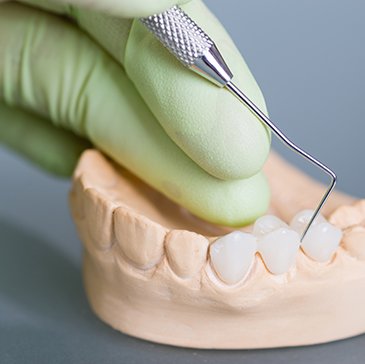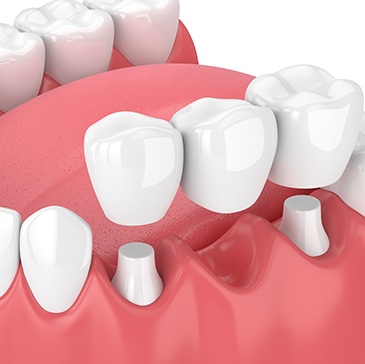Dental Bridges – Waco, TX
Bridge the Gap, Restore Your Smile

Are you missing one tooth? Maybe you’re missing several teeth in a row following a sports-related injury or accident. In both cases, we recommend coming to our Waco dental office to explore your tooth-replacement options! Dental bridges are a tried-and-true solution that can help in both cases. Plus, they are custom-made for each patient, ensuring they look great and fit perfectly. If you want to learn more, you can schedule a consultation with one of our talented dentists or read on.

Why Choose Premier Family Dental for Dental Bridges?
- Morning, Lunchtime, and Afternoon Hours
- Entire Dental Implant Procedure Performed In-House
- Treatments Performed Using the Latest Dental Technology
What is a Dental Bridge?

As you may have assumed from the name, a dental bridge literally bridges the gap in your smile following tooth loss. This tooth-replacement solution is comprised of two components: the replacement teeth and the restorations holding them in place. Since they are custom-made for each patient and crafted from only the best materials, you can have peace of mind knowing that the final result will be a complete smile that looks and feels natural.
Types of Dental Bridges

Our Waco dental team proudly offers two types of dental bridges: traditional and implant-retained. Below, you can find a little more information on each. However, if you have a question or you want to find out which one is best for your unique dental needs and smile goals, then don’t hesitate to give us a call to schedule a consultation!
Traditional Dental Bridge
Traditional dental bridges are used to replace one missing tooth or a few teeth in a row. In this case, the replacement teeth are securely anchored in position with two dental crowns, which are placed on the teeth surrounding the gap. Sometimes, this requires healthy enamel to be altered, but the improvement to the look, health, and function of your smile makes it well worth it.
Implant Bridge
An implant bridge, on the other hand, uses dental implants, not dental crowns. For that reason, it’s typically only recommended when patients are missing three or more teeth. If you are a candidate for this tooth-replacement solution, then your healthy teeth will remain untouched. Plus, the results can last for several decades with proper care!
The Benefits of Getting a Dental Bridge

Dental bridges are popular because:
- They improve your oral health by preventing dental drift
- They are easy to maintain
- They can last for 10+ years
- They are custom-made for each patient, ensuring they look and feel natural
- They restore some of the strength of your bite
Dental Bridges FAQs
Are Dental Bridges Removable?
Dental bridges are a convenient way to replace one or several consecutively missing teeth, but many patients near Waco wonder whether they’re intended to be easily removed and reinserted. Some of this confusion may stem from the fact that some providers refer to partial dentures as “removable bridges,” but they are actually two very different treatments.
Partial dentures are indeed meant to be easily taken out for cleanings, but dental bridges are cemented in place and aren’t intended to come off without the help of our Premier Family Dental team. You can eat, drink, and complete your daily dental hygiene routine with them in your mouth.
What Are Dental Bridges Made Of?
These prosthetics can be made from various materials, depending on your provider and your unique situation. For instance, they can be designed from metallic materials for durability, or porcelain-fused-to-metal options that look more natural.
However, our Premier Family Dental providers use resilient, tooth-colored materials that are just as long-lasting as the alternatives. Plus, this material can be customized to be just the right shade, shape, and size to match your natural smile for seamless results.
Does Getting a Dental Bridge Hurt?
Many patients experience anxiety around dental appointments, especially if they have a major procedure like replacing missing teeth. It’s natural to want to avoid long, agonizing treatments, but thankfully, that’s not the case with these prosthetics.
Firstly, our team will administer a local anesthetic before beginning to prevent the nerves in your mouth from sending pain signals to your brain. We also offer nitrous oxide (laughing gas) and oral conscious sedative options to keep you calm and comfortable. You might develop some sensitivity if we must remove some enamel for your bridge to fit correctly over your natural teeth, but this usually resolves itself after a few days.
Usually, it’s safe to take Tylenol or ibuprofen to address any associated aches and inflammation, but if you experience severe or persistent throbbing, please contact us so we can ensure your bridge fits correctly.
How Long Do Dental Bridges Usually Last?
Typically, most of these restorations last anywhere from 5 to 15+ years, though it depends significantly on your unique situation. Several factors can affect their longevity, such as:
- Oral hygiene habits. Your prosthetic can’t get cavities, but your natural teeth still can. If tooth decay goes unaddressed, it can erode the abutment teeth holding your bridge in place, or spread to your gums to cause an infection that causes them to retract, leaving it without enough of a foundation to remain firmly in place.
- Where it’s located. Although bridges are durable, they usually need to be replaced eventually because they wear down with years of daily use. Restorations in the back of the mouth sustain additional pressure from chewing with your molars that can chip, creak, break, or dislodge them sooner than ones in the front.
- Your diet. Eating overly hard foods, like ice, candy, and nuts, can injure or fracture your new teeth and overly sticky options can yank them out of place.
You can elongate their lifespan by brushing and flossing twice daily and scheduling a routine checkup and cleaning with our team every six months.
Is a Partial Denture the Same as a Bridge?
No, a dental bridge is not the same thing as a partial denture. While partial dentures are sometimes referred to as “removable bridges,” they are not the same thing as a traditional fixed dental bridge.
A dental bridge is designed to stay in place for many years and can only be removed by a dentist; however, a patient can remove their partial denture at any time.
The other main difference between dental bridges and partial dentures is that bridges can only replace teeth if they are consecutive, whereas partial dentures can restore several teeth at various points along the arch.
Dental bridges are anchored in place via crowns that are fitted over two of your remaining natural teeth, while partial dentures use metal clips or clasps that go behind the natural teeth.
Your dentist can review your options with you to help you determine which tooth replacement method is best for your individual needs.
How Many Teeth Can a Dental Bridge Replace?
Depending on your individual needs, a dental bridge can replace anywhere from one to four missing consecutive teeth. However, in most cases dental bridges only replace one or two teeth.
This is because the longer your bridge extends, the less stable it can become, especially if the natural teeth supporting it aren’t strong and healthy. Thus, it may become risky to have a bridge replace three or more teeth.
Implant bridges can often lower this risk, as dental implants are just as strong and secure as your natural teeth, if not more so!
Can Dental Bridges Be Whitened?
No matter the type of material your bridge is made of it cannot be whitened like your natural teeth can.
Tooth enamel has tiny pores throughout which bleaching gels can enter and break apart stains. Dental restorations like bridges do not, and therefore your bridge should always remain the same color.
Metal-free dental bridges are designed to blend seamlessly with your remaining teeth; to minimize the risk of your natural teeth becoming discolored and making your dental bridge stand out in your smile, consider asking your dentist about professional whitening before your new bridge is placed. This way, your bridge will be matched to your ideal shade of white teeth!
Do Dental Bridges Look Natural?
Metal free dental bridges are made from a variety of natural looking materials such as ceramic and zirconia. These can be matched to your existing teeth and look remarkably realistic.
Once placed, your dental bridge should blend in seamlessly with the rest of your smile. Furthermore, unlike dentures or partials, you won’t need to worry about your bridge falling out or slipping when you speak or chew!
